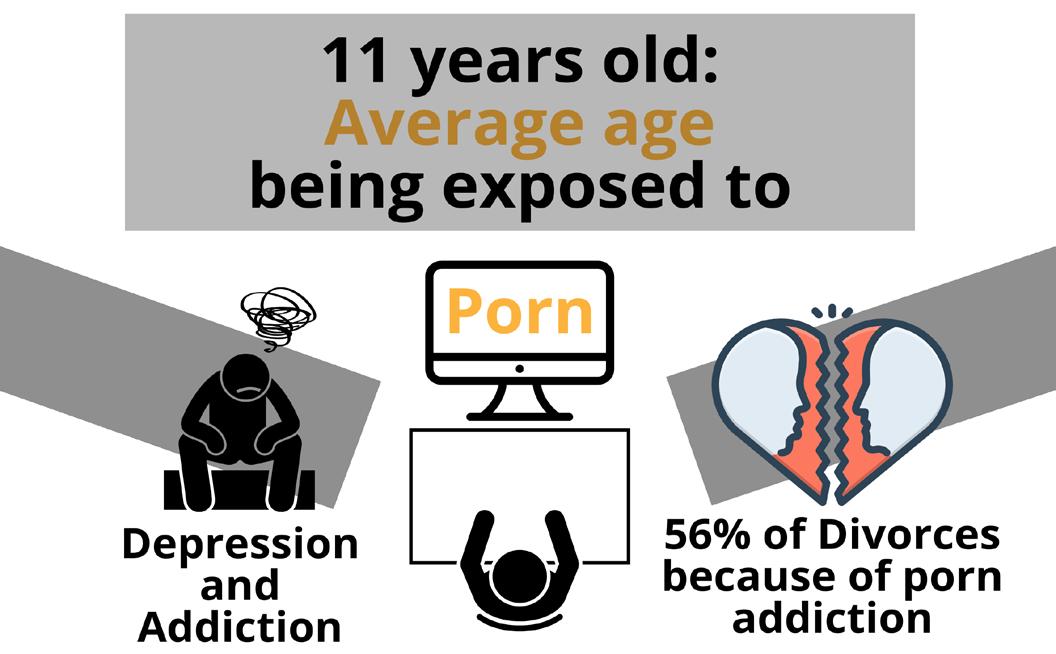
2 minute read
The Most Convenient “Drug”
The alarming rise in use of porn, and effects it has on teens.
Maddox Rosenberg Image Editor
Advertisement
According to troubledteens.com, “Teen pornography exposure is becoming more and more common with almost 87% of teens now online on a regular basis. Only 3% of boys and 17% of girls have never watched pornography. The average age that youth are exposed to pornography is age 11.”
Pornography addiction. An uncomfortable and taboo topic, but very important to address. Pornography, although not normally thought of as a drug, is highly addictive in nature. In fact, it is the easiest drug to get a hold of due to the computers we carry around in our pockets.
This growing rate is highly alarming. Even though most people think that the use and exposure of pornography is specifically a male issue, there is an exponential rise in the number of women and teen girls watching in the past few years. This is most definitely due to the ease of access on everyone’s phones. An article that summarizes statistics directly from Pornhub claims that 71% of its female users access their website using their phones.
An issue noted in an article by axis.org (a website designed to help parents raise kids in a more biblical way) is that “the pornification of culture (i.e. softcore and hypersexualized imagery) is widespread and evident everywhere, from the grocery store checkout lane to advertising, popular entertainment, unsolicited email, and beyond. It’s becoming increasingly difficult—if not impossible—to live a porn-free life.” This highly sexual imagery is becoming the new normal, and the sheer amount of it that people are exposed to now is what has the scary ability to shape today’s culture.
As stated earlier, pornography is a very addictive drug, and it is everywhere. Prolonged exposure and use can have physical consequences such as erectile dysfunction. Pornography can also change the chemistry of your brain.
An article by Rachel Anne Barr on neurosciencenews.com
states that “some scientists have drawn parallels between porn consumption and substance abuse. Through evolutionary design, the brain is wired to respond to sexual stimulation with surges of dopamine. This neurotransmitter, most often associated with reward anticipation, also acts to program memories and information into the brain. This adaptation means that when the body requires something, like food or sex, the brain remembers where to return to experience the same pleasure.”
Because of the amount of dopamine one can get from pornography, this can lead to addiction—which is what makes it so similar to drug use. It causes surges of “good feelings” because of this dopamine, which can lower overall mood and cause people to fall into depression.
A shocking statistic from bevilandassociates.com, a professional counseling site, is that 56% of divorce cases are because one party is addicted to pornography. This is detrimental to marriage and relationships in general because it shows less commitment to one’s partner, and once addiction starts, it gets harder to break the longer it goes on.
Addiction, in general, is detrimental to the mind and body. But the fact that this new type of addiction is so often found in the hands of younger and younger adolescents is highly alarming. It is everywhere we look, and society has become desensitized to how harmful it is to be seeing that type of graphic imagery regularly.
The images people view and take in daily affect how they and the entirety of society thinks, and if that imagery is pornographic and addictive, that shows in the way society begins to collectively think of what it means to be in healthy relationships. And if young people are influenced more and more by this imagery, the next generation will surely see its detriment to society.











